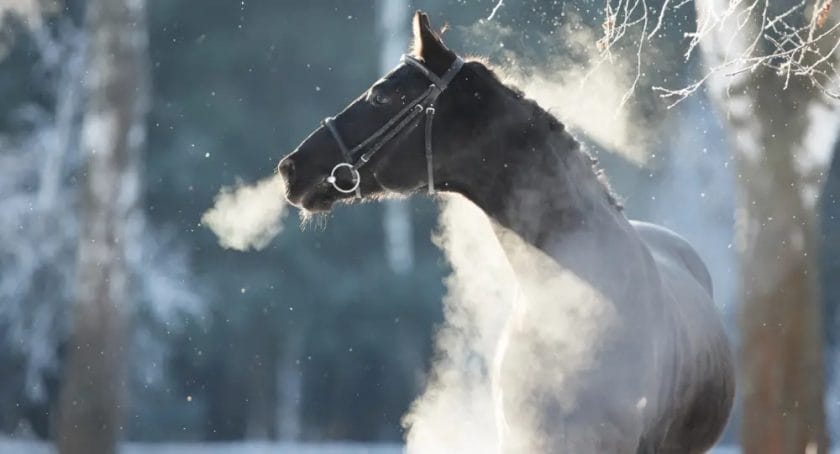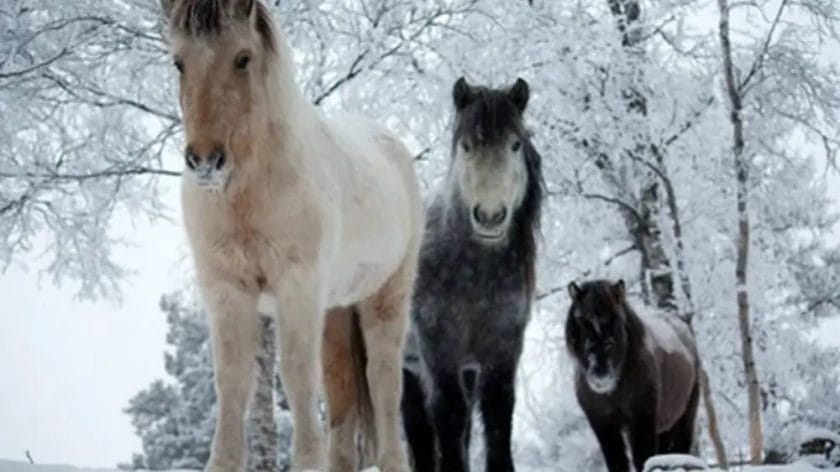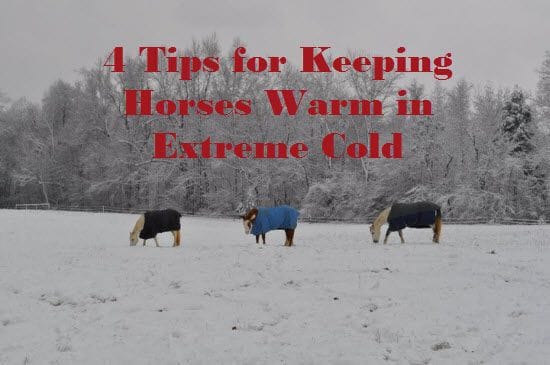When it comes to extreme cold weather, it’s crucial to ensure that our equine friends stay warm and comfortable.
By providing adequate shelter such as a well-insulated stable or a waterproof blanket, you can help protect your horses from harsh temperatures and wind chills.
Proper nutrition is also essential during colder months, as it aids in maintaining their body heat. Offering high-quality forage and increasing their grain intake can provide them with the necessary energy to stay warm.
Regular exercise is another key factor as it helps stimulate blood circulation and generates natural heat within their bodies.
Lastly, don’t forget to monitor your horse’s body condition and check for any signs of hypothermia or frostbite. Prompt action and proper care can go a long way in keeping your horses safe and cozy during extreme cold spells.

Creating a Cozy Shelter for Your Horse
Providing a cozy shelter for your horse is essential to ensure its comfort and well-being. Whether you have a horse as a pet or for riding, a shelter will protect it from harsh weather conditions and give it a safe space to rest. In this section, we will discuss the key considerations and steps involved in creating a cozy shelter for your horse.
1. Location and Orientation
The first step in creating a horse shelter is choosing the right location. Look for an area that is well-drained and away from low-lying spots prone to flooding. A slightly elevated area will help prevent water accumulation in the shelter. Additionally, consider the prevailing winds in your region and position the shelter to provide protection from strong winds and storms.
2. Size and Design
The size of the shelter will depend on the number of horses you have. A general guideline is to provide a minimum of 12×12 feet per horse. However, larger is always better to give your horse more room to move around comfortably. The design of the shelter should be sturdy and durable to withstand various weather conditions.
Consider using materials such as pressure-treated wood or metal for the framework and durable roofing materials like metal or asphalt shingles. Ensure that the roof has a slight slope to allow water to run off and prevent leakage. It is also advisable to have open sides or ventilation openings to maintain good air circulation.
3. Flooring and Bedding
The flooring of the shelter should be designed to provide good drainage and prevent the accumulation of mud and moisture. A common recommendation is to use gravel or crushed stone as the base, which allows water to drain easily. Additionally, providing bedding such as straw, wood shavings, or rubber mats on top of the base will offer additional comfort and insulation for your horse.
4. Access and Security
Ensure that the shelter has easy access for both you and your horse. It should have a wide entrance that allows the horse to enter and exit without difficulty. Installing a gate or a removable panel can help control access and secure the area when needed. Additionally, make sure the shelter is well-lit for nighttime visits and surveillance.
5. Maintenance and Cleaning
Regular maintenance and cleaning of the shelter are crucial to ensure its longevity and hygiene. Remove any manure or soiled bedding regularly to prevent the build-up of odors, pests, and disease. Inspect the structure for any signs of damage and make repairs promptly to keep the shelter safe and secure.
In summary, creating a cozy shelter for your horse involves considering the location, size, design, flooring, access, security, and maintenance. By providing a comfortable and well-protected shelter, you can ensure the well-being of your horse and enhance your equestrian experience.

Warm Clothing and Blanketing Techniques
As the temperature drops, it is important to protect yourself from the cold weather. This can be achieved through the use of warm clothing and effective blanketing techniques. In this section, we will discuss the importance of wearing appropriate clothing and provide tips on how to effectively use blankets to stay warm.
1. Importance of Warm Clothing
When it comes to staying warm in cold weather, the type of clothing you wear plays a crucial role. Here are some key points to consider:
- Layering: Layering your clothing helps to trap warm air between the layers, providing insulation and keeping you warm. Start with a base layer made of moisture-wicking material, add a middle layer for insulation, and finish with an outer layer that is waterproof and windproof.
- Insulating Materials: Opt for clothing made from insulating materials such as wool or fleece. These materials provide excellent insulation and retain heat effectively.
- Proper Fit: Ensure that your clothing fits well, as loose or ill-fitting garments can allow cold air to enter and warm air to escape.
- Protective Accessories: Don’t forget to wear a hat, gloves, and scarf to protect your head, hands, and neck from heat loss. These areas are especially vulnerable to cold temperatures.
2. Effective Blanketing Techniques
In addition to wearing warm clothing, using blankets strategically can enhance your comfort and warmth. Here are some techniques to consider:
- Layering Blankets: Just like layering clothing, layering blankets can provide extra insulation. Start with a lightweight blanket as a base layer and add thicker blankets on top to trap more heat.
- Choose the Right Material: Opt for blankets made from materials such as wool or fleece, as they are excellent at retaining heat.
- Covering Exposed Areas: Pay attention to areas that are prone to heat loss, such as your feet and head. Use additional blankets or a hat to provide extra warmth to these areas.
- Sealing Drafts: If you feel cold drafts coming from windows or doors, use a draft stopper or rolled-up towels to seal the gaps and prevent cold air from entering.
- Electric Blankets: Consider using an electric blanket for added warmth. These blankets have adjustable heat settings and can provide targeted warmth to specific areas.
By implementing these warm clothing and blanketing techniques, you can ensure that you stay comfortable and protected from the cold weather. Remember to dress in layers, choose appropriate materials, and cover exposed areas to maximize warmth. Additionally, using blankets strategically and sealing drafts can further enhance your comfort. Stay cozy and enjoy the winter season!

Feeding Strategies for Cold Weather
When winter arrives and the temperature drops, animals face a variety of challenges in finding food to sustain themselves. Cold weather can make it difficult for animals to survive, as it reduces the availability of food sources and increases the energy requirements needed to keep warm. In this section, we will explore some effective feeding strategies that animals employ to cope with the harsh conditions of cold weather.
1. Food Storage
One common feeding strategy for animals in cold weather is food storage. Many species, such as squirrels and birds, have the ability to hoard food during times of plenty to secure a future food source. These animals have the remarkable ability to remember the location of their stored food, even buried under layers of snow. By creating hidden food caches, they ensure a steady supply of sustenance throughout the winter.
2. Changing Diets
In colder climates, the availability of certain food sources may decline during the winter months. This forces animals to switch their diets and adapt to alternative food sources. For example, herbivores may resort to consuming bark, twigs, or moss when green vegetation is scarce. Carnivores, on the other hand, may shift their focus to preying on smaller animals or scavenging for carrion.
3. Increased Foraging
In order to meet their increased energy demands during cold weather, animals may need to spend more time foraging for food. They may venture further from their shelters or nests in search of available food sources. This increased foraging not only helps animals meet their nutritional needs but also provides them with crucial physical activity to generate body heat and maintain their metabolic functions.
4. Migration
Some animals, particularly birds, employ a strategy of migration to cope with the challenges of cold weather. By traveling to warmer regions, they can escape the harsh conditions and find abundant food sources. Migration requires careful timing and navigation skills, as animals must make long journeys to reach their wintering grounds and return to their breeding grounds when the weather improves.
5. Hibernation
During extremely cold weather, some animals have evolved the ability to enter a state of hibernation. This strategy involves a significant reduction in metabolic rate and overall activity, allowing animals to conserve energy during periods of food scarcity. By lowering their body temperature and slowing down their physiological processes, hibernating animals can survive for extended periods without needing to search for food.
6. Supplemental Feeding
Humans can also play a role in supporting wildlife during the winter by providing supplemental feeding. This involves providing food sources, such as bird feeders or food stations, to help animals navigate through periods of food scarcity. Supplemental feeding can be especially beneficial for bird species that rely on seeds, berries, or nectar, as these food sources may be limited during cold weather.
In summary, animals employ various feeding strategies to cope with the challenges of cold weather. Whether through food storage, changing diets, increased foraging, migration, hibernation, or supplemental feeding, these strategies allow animals to adapt and survive during the winter months. Understanding these feeding strategies can help us appreciate the resilience and resourcefulness of wildlife in the face of harsh environmental conditions.
Exercise and Mental Stimulation for Your Horse in Winter
As the winter months approach, it is important to ensure that your horse continues to receive regular exercise and mental stimulation. The cold weather and limited daylight can often make it challenging to maintain the same level of activity as during the warmer months. However, by implementing a few strategies, you can keep your horse happy and healthy throughout the winter season.
Create a Winter Turnout Routine
One of the key aspects of providing exercise for your horse during winter is establishing a consistent turnout routine. Even if the weather is cold or snowy, it is still important for your horse to have access to the outdoors. Create a schedule that allows for daily turnout, taking into consideration the weather conditions and the safety of your horse. A few hours outside in a paddock or pasture can provide essential exercise and allow your horse to stretch his legs.
Incorporate Indoor Exercise
When the weather is particularly harsh, it may be necessary to incorporate some indoor exercise options for your horse. This can include activities such as lunging, long-lining, or using an equine treadmill if available. These exercises can help to maintain muscle tone, improve cardiovascular fitness, and provide mental stimulation for your horse. Additionally, you can set up obstacle courses or ground poles in an indoor arena to add variety and challenge to your horse’s exercise routine.
Implement Mental Stimulation
Keeping your horse mentally stimulated during the winter is just as important as providing physical exercise. Lack of mental stimulation can lead to boredom and undesirable behaviors such as cribbing or weaving. To keep your horse engaged, consider introducing interactive toys or treat dispensers that require problem-solving skills. You can also vary your horse’s feeding routine by using hay nets or slow feeders to mimic grazing behavior, which will keep your horse occupied for longer periods of time.
Training Sessions
Winter can be an ideal time to focus on training sessions with your horse. Use this time to work on groundwork exercises, obedience training, or introducing new skills. By engaging your horse’s mind in training activities, you can provide mental stimulation while also strengthening your bond with your horse. Remember to keep training sessions short and positive, as horses can become more easily frustrated in the confined space of an indoor arena.
Consider Equine Enrichment Activities
Equine enrichment activities can be a great way to provide both physical exercise and mental stimulation during the winter months. These activities can include trail rides, horseback games, or even obstacle courses. Not only do these activities keep your horse physically fit, but they also provide a change of scenery and add excitement to your horse’s routine.
In Summary
Winter can present some challenges when it comes to exercising and mentally stimulating your horse. However, by implementing a consistent turnout routine, incorporating indoor exercise options, providing mental stimulation, focusing on training sessions, and considering equine enrichment activities, you can ensure that your horse remains active and engaged throughout the winter season. Remember to always prioritize your horse’s safety and well-being, and consult with a veterinarian or equine professional for specific guidance tailored to your horse’s needs.
FAQs
Q: How can I keep my horses warm in extreme cold weather?
To keep horses warm in extreme cold weather, provide them with a shelter such as a barn or a run-in shed. Use blankets or rugs specifically designed for horses to provide extra insulation. Increase their forage intake to help generate heat through digestion. Ensure access to unfrozen water and add additional bedding to their stalls.
Q: Should I leave my horse’s mane long in winter to keep them warm?
No, leaving a horse’s mane long does not significantly contribute to keeping them warm in winter. Instead, focus on providing adequate shelter, blankets, and increased forage to ensure their warmth. Trimming the mane may help prevent snow and ice build-up, reducing the risk of discomfort or injury.
Q: Should I exercise my horse in extreme cold weather?
It is generally not recommended to exercise horses in extreme cold weather, as it can strain their respiratory system and increase the risk of injury. Provide them with ample turnout time in a sheltered area, and consider light exercise indoors, such as lunging or hand-walking, if necessary.
Conclusion
Wrapping Up: Ensuring the warmth and well-being of your horses in extreme cold is crucial for their health and comfort. By implementing a few key strategies, you can keep your equine companions cozy and safe throughout the winter months.
Providing adequate shelter, such as a well-insulated barn or sturdy windbreak, is essential. Additionally, offering ample amounts of high-quality hay and water will help keep your horses warm from the inside out.
Investing in appropriate winter horse blankets or rugs can also provide an extra layer of protection against the cold. Regular health checks and monitoring for signs of discomfort or hypothermia will further ensure your horses’ well-being during extreme cold weather.
Remember, with proper preparation and care, you can help your horses stay warm and thrive even in the coldest of winters.
